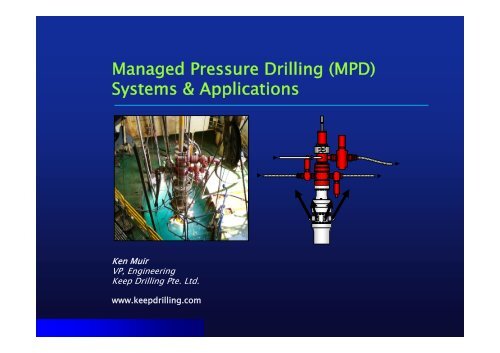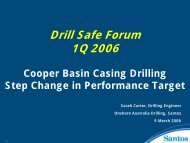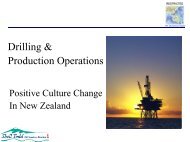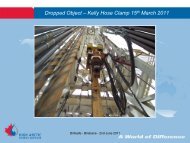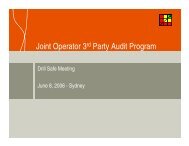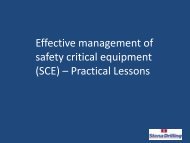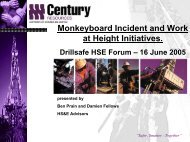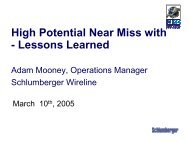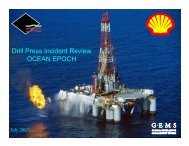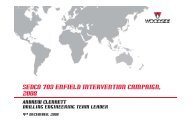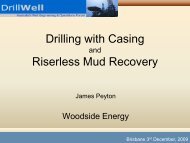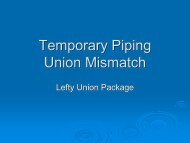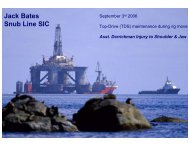Managed Pressure Drilling (MPD) Systems & Applications - DrillSafe
Managed Pressure Drilling (MPD) Systems & Applications - DrillSafe
Managed Pressure Drilling (MPD) Systems & Applications - DrillSafe
You also want an ePaper? Increase the reach of your titles
YUMPU automatically turns print PDFs into web optimized ePapers that Google loves.
<strong>Managed</strong> <strong>Pressure</strong> <strong>Drilling</strong> (<strong>MPD</strong>)<br />
<strong>Systems</strong> & <strong>Applications</strong><br />
Ken Muir<br />
VP, Engineering<br />
Keep <strong>Drilling</strong> Pte. Ltd.<br />
www.keepdrilling.com
<strong>Managed</strong> <strong>Pressure</strong> <strong>Drilling</strong> – WHY<br />
• Conventional <strong>Drilling</strong> hasn’t changed much in over 100<br />
years – it’s still an “Open to Atmosphere” system<br />
• The easy drilling is behind us – drilling problems are<br />
increasing – and it’s getting worse<br />
• <strong>Drilling</strong> performance curve is flat - technology advances<br />
are cancelled out by increased drilling problems<br />
• Independent studies reveal that 25 – 33% of new wells<br />
can’t be drilled conventionally<br />
• <strong>Drilling</strong> costs are now higher<br />
than facilities costs (used to<br />
be the other way round)<br />
• <strong>MPD</strong> is a safer drilling<br />
method<br />
• We need a better way to drill<br />
2
<strong>Drilling</strong> Methods<br />
OVERBALANCED DRILLING: <strong>Drilling</strong> with BHP higher than<br />
formation pressure = CONVENTIONAL DRILLING.<br />
Objective: To minimise the chance of an influx.<br />
PERFORMANCE DRILLING: <strong>Drilling</strong> with low BHP to enhance ROP &<br />
bit life. Used in well construction = AIR or GAS DRILLING.<br />
Objective: To enhance penetration rate<br />
UNDERBALANCED DRILLING: <strong>Drilling</strong> with the BHP below reservoir<br />
pressure – naturally lower or induced = UBD.<br />
Objective: To minimise reservoir damage<br />
MANAGED PRESSURE DRILLING: <strong>Drilling</strong> with precisely controlled<br />
BHP to avoid influx, fluid loss or borehole instability. <strong>Pressure</strong><br />
profile managed by addition of surface pressure or by change in<br />
hydrostatics or friction pressure.<br />
Objective: To minimise pressure related drilling problems<br />
3
<strong>MPD</strong> Advantage<br />
Conventional <strong>Drilling</strong>:<br />
BHP = MW + Annulus Friction <strong>Pressure</strong><br />
BHP control = only pump speed & MW change,<br />
because it’s an “Open to Atmosphere” System.<br />
<strong>Managed</strong> <strong>Pressure</strong> <strong>Drilling</strong> (<strong>MPD</strong>):<br />
BHP = MW + Annulus Friction <strong>Pressure</strong> + Backpressure<br />
BHP control = pump speed change, MW change &<br />
application of back-pressure, because it’s an<br />
“Enclosed, Pressurized System”.<br />
4
<strong>MPD</strong> Advantage<br />
IADC Definition:<br />
•“The objectives are to ascertain the downhole<br />
pressure environment limits and to manage the<br />
annular hydraulic pressure profile accordingly”<br />
•<strong>MPD</strong> does not change the downhole pressure<br />
window – pore pressure and fracture gradient remain<br />
unchanged<br />
•but <strong>MPD</strong> helps us to remain in the “window”<br />
5
Problem Incidents – GoM Gas Wells<br />
<strong>MPD</strong> can reduce NPT<br />
in 43% of problems<br />
Rig Failure<br />
21%<br />
Other<br />
1%<br />
Kick<br />
9% Gas Flow
Who is using <strong>MPD</strong><br />
7
<strong>MPD</strong> System Components<br />
Conventional BOP & Choke Manifold (no change)<br />
8
Automated <strong>MPD</strong> System<br />
9
Manual CBHP System<br />
Make a connection and keep BHP within a 50psi window<br />
Step<br />
Choke<br />
<strong>Pressure</strong><br />
(psi)<br />
Pump<br />
Rate<br />
(gpm)<br />
Pump<br />
(spm)<br />
Pump<br />
Press<br />
(psi)<br />
Friction<br />
DP (psi)<br />
BHP<br />
(psi)<br />
Pump Rate while drilling 20 196 70 2995 393 1566<br />
Increase choke pressure 48 197 70 3003 393 1617<br />
Decrease pump rate 48 183 65 2646 345 1566<br />
Increase choke pressure 113 183 65 2691 345 1611<br />
Decrease pump rate 113 170 60 2395 300 1566<br />
Increase chore pressure 155 170 60 2397 258 1608<br />
Decrease pump rate 155 155 55 2081 258 1566<br />
And continue with steps until pumps are stopped<br />
Decrease pump rate 323 85 30 990 90 1566<br />
Increase chore pressure 347 85 30 1014 90 1590<br />
Decrease pump rate 347 71 25 931 66 1566<br />
Increase choke pressure 359 71 25 843 66 1578<br />
Decrease pump rate 359 45 16 596 54 1566<br />
Increase chore pressure 413 45 16 650 54 1620<br />
Decrease pump rate 413 0 0 413 0 1566<br />
50psi<br />
range<br />
10
Types of <strong>MPD</strong><br />
• Returns Flow Control (Enclosed wellbore vs. opento-atmosphere)<br />
• Pressurized or Floating Mud Cap <strong>Drilling</strong> (PMCD)<br />
• Constant Bottom Hole <strong>Pressure</strong> (CBHP)<br />
• Dual gradient (DG)<br />
MW<br />
MW + ECD<br />
<strong>MPD</strong> allows the BHP to be<br />
adjusted to penetrate the<br />
“Windows” between Pore<br />
<strong>Pressure</strong> & Fracture<br />
<strong>Pressure</strong><br />
Fracture<br />
<strong>Pressure</strong><br />
Pore<br />
<strong>Pressure</strong><br />
11
Pore – Fracture <strong>Pressure</strong> Window<br />
Easy to drill wells in a large “<strong>Drilling</strong> Window”<br />
Overburden<br />
<strong>Pressure</strong><br />
Fracture<br />
<strong>Pressure</strong><br />
Collapse<br />
<strong>Pressure</strong><br />
Pore<br />
<strong>Pressure</strong><br />
12
Pore – Fracture <strong>Pressure</strong> Window<br />
Narrow “<strong>Drilling</strong> Windows” are not easy to drill<br />
Overburden<br />
<strong>Pressure</strong><br />
Collapse<br />
<strong>Pressure</strong><br />
Narrow<br />
<strong>Drilling</strong><br />
Window<br />
Pore<br />
<strong>Pressure</strong><br />
Fracture<br />
<strong>Pressure</strong><br />
13
Constant Bottom Hole <strong>Pressure</strong> – CBHP<br />
Fluid Losses<br />
Fluid Losses<br />
Bottom Hole Circulating <strong>Pressure</strong><br />
Bottom Hole <strong>Pressure</strong><br />
Fracture<br />
<strong>Pressure</strong><br />
Reservoir<br />
<strong>Pressure</strong><br />
Time<br />
14
Constant Bottom Hole <strong>Pressure</strong> – CBHP<br />
Bottom Hole <strong>Pressure</strong><br />
Bottom Hole Circulating <strong>Pressure</strong><br />
Kick<br />
Kick<br />
Fracture<br />
<strong>Pressure</strong><br />
Reservoir<br />
<strong>Pressure</strong><br />
Time<br />
15
Automated <strong>MPD</strong> System – Reaming to Bottom<br />
Tool Joints<br />
16
Automated <strong>MPD</strong> System<br />
Kick Tolerance is greatly reduced<br />
17
Automated <strong>MPD</strong> System<br />
409 psi = 73 gpm<br />
of mud loss<br />
339 psi = 5 gpm<br />
of mud loss<br />
Accurate determination of the fracture gradient<br />
18
Low <strong>Pressure</strong> RCD<br />
Over 600 wells are drilled with Rotating Control<br />
Devices (RCD) every day in the US & Canada<br />
Low pressure<br />
RCD with spare<br />
seal elements<br />
and components<br />
for pressure<br />
testing and<br />
logging.<br />
<strong>Pressure</strong> Rating:<br />
Rotating and/or<br />
Stripping:500psi<br />
Static: 1,000psi<br />
19
High <strong>Pressure</strong> RCD<br />
<strong>Pressure</strong> Rating:<br />
Rotating and/or<br />
Stripping:2,500psi<br />
Static: 5,000psi<br />
20
PMCD System – Floating Rig<br />
Rotating Control<br />
Device<br />
6” HCR<br />
2” Fill-up Line from<br />
Trip Tank Pump<br />
6” Line Flow Line<br />
4” HCR<br />
4” Annulus Injection Line<br />
from Mud Pump<br />
4” HCR<br />
4” Bleed-off Line to<br />
Choke Manifold<br />
Riser Slip Joint used in<br />
the collapsed position<br />
Riser tensioner lines<br />
support the full riser<br />
weight and PMCD<br />
equipment<br />
21
PMCD System – Floating Rigs<br />
Semi-submersible<br />
Drillship<br />
<strong>MPD</strong> has already been performed on Drillships, Semi-subs,<br />
Jack-ups & Platform Rigs<br />
22
Automated <strong>MPD</strong> – Floating Rig<br />
• Full Automated <strong>MPD</strong> System for<br />
floating rig applications in harsh<br />
environment conditions<br />
• Project due to commence July 2008<br />
23
<strong>MPD</strong> <strong>Applications</strong><br />
• Kick Control (Influx Control)<br />
• Severe <strong>Drilling</strong> Fluid Loss – Fractured or<br />
Vugular Formation<br />
• Differential Sticking – Stuck Pipe – Twist-off<br />
• Tight Pore <strong>Pressure</strong> – Fracture <strong>Pressure</strong><br />
“Windows”<br />
• Depleted Reservoir <strong>Drilling</strong><br />
• HPHT <strong>Drilling</strong><br />
• Unknown Pore <strong>Pressure</strong><br />
24
<strong>MPD</strong> <strong>Applications</strong> contd.<br />
• Unstable Wellbore (Wellbore Instability)<br />
• <strong>MPD</strong> + ERD (Extended Reach <strong>Drilling</strong>)<br />
• Low ROP<br />
• Drilled Gas (Nuisance Gas)<br />
• High H 2 S Levels<br />
• High ECD<br />
• Ballooning / Breathing formation<br />
25
KICK CONTROL – Advantages of <strong>MPD</strong><br />
Safety<br />
• Response and influx size reduced using an enclosed system<br />
• Enclosed wellbore is safer than “open to atmosphere” system<br />
because back-pressure can be applied immediately<br />
• The majority of kicks are low pressure events that can easily<br />
be handled by an RCD<br />
• Lower risk of exceeding MAASP with <strong>MPD</strong> (because of the<br />
smaller influx) and consequently lower risk of breaking down<br />
the casing shoe<br />
Time &<br />
Cost<br />
• Lower risk of taking second influx with <strong>MPD</strong> (longer critical<br />
choke control needed while circulating out the larger influx)<br />
• The drillstring can be moved all the time, reducing the risk of<br />
differential sticking – potential huge cost saving<br />
• One full circulation at slow circulating rate can take hours,<br />
plus time to weight up the kill mud. Typically 12 – 24 hours<br />
can be saved (the time loss varies – GOM deepwater – the<br />
average time loss due to taking a kick is 10 days)<br />
• Reduces wear & tear on BOP and rig choke system<br />
26
PMCD – Advantages & Disadvantages<br />
Advantages<br />
• Permits safe and efficient drilling through severe or total<br />
loss zones – highly cost effective compared to<br />
conventional drilling<br />
• Well can be drilled to TD with virtually no loss of rig time<br />
– no major AFE Overruns<br />
• Limits damage to the reservoir caused by LCM, gunk<br />
and cement<br />
Disadvantages<br />
• Very good technique for H 2 S environments because the<br />
gas is pushed back into formation – no gas to surface<br />
• There are no returns to surface – Geologists don’t like<br />
this technique – no samples<br />
• At TD, or for intermediate trips, there still remains the<br />
issue of how to get out of the hole with total losses –<br />
casing valve or pumping technique<br />
• PMCD uses large volumes of fluid – a week of drilling<br />
could require 120 – 150,000bbls of fluid including<br />
drillpipe & annulus injection<br />
27
Case History<br />
•Ran 7” casing “tie-back” string to<br />
top of liner hanger with casing<br />
valve to allow drillstring recovery<br />
•Changed to PMCD<br />
•Injected water in annulus with<br />
high surface pressure on RCD<br />
(1,400psi)<br />
•Drilled out tie-back shoe, gunk<br />
plug plus 3m of new formation.<br />
POOH closing casing valve to<br />
isolate reservoir pressure<br />
•Reservoir section drilled in two<br />
further trips<br />
• SPP range 1,900 – 2,100psi<br />
• CP range 1,250 – 1,400psi<br />
• ROP ~ 4 – 5 metres/hour<br />
7” Tie-back<br />
casing string<br />
Casing Valve<br />
28
<strong>MPD</strong> + ERD<br />
PROBLEM: Compare two<br />
wells of 3,500mMD. A<br />
vertical well with APL of<br />
478psi and 10.6ppg ECD<br />
using 9.8ppg mud, and<br />
an ERD well with TVD of<br />
2,000m. The ERD well<br />
would have the same APL<br />
but an ECD of 11.2ppg.<br />
X Greatly increased ECD<br />
X At reduced depth –<br />
weaker formation<br />
ECD (ppg) = Annular <strong>Pressure</strong> Loss (psi) / 0.052<br />
/ TVD (ft) + Current Mud Density (ppg)<br />
<strong>MPD</strong> SOLUTION: Drill with<br />
9.3ppg mud giving a<br />
10.6ppg ECD and trap<br />
annulus pressure during<br />
connections to control<br />
any influx or maintain<br />
wellbore stability<br />
29
High ECD<br />
PROBLEM:<br />
• While drilling a 6-1/8” hole at 3,064mTVD with 13.2ppg mud and<br />
an APL of 575psi, ECD is so high that losses are being caused. The<br />
pump rate must be reduced and ROP controlled to avoid hole<br />
cleaning problems and stuck pipe<br />
• Circulating BHP adds 1.1 – 1.6ppg, so ECD = 14.3 – 14.8ppg<br />
<strong>MPD</strong> SOLUTION:<br />
• Drill with a light fluid. Can be<br />
statically balanced but with the<br />
<strong>MPD</strong> system for additional<br />
security<br />
• Eliminate the 0.5ppg drilling<br />
margin – enclosed wellbore<br />
• Or go statically underbalanced<br />
with a 12.1ppg MW and trap<br />
575psi in the annulus on the<br />
choke during connections (ECD<br />
= 13.2ppg)<br />
MW<br />
Pore<br />
<strong>Pressure</strong><br />
MW + ECD<br />
FractureP<br />
ressure<br />
30
Ballooning / Breathing Formation<br />
PROBLEM:<br />
• The formation charges up with fluid and pressure while drilling<br />
and releases this fluid pressure back into the wellbore when<br />
the pumps are shut down<br />
• The drilling supervisor thinks the well is flowing and orders the<br />
mud weight increased – which increases the BHP – which<br />
charges up the formation even more – so it flows even more at<br />
the next connection<br />
<strong>MPD</strong> SOLUTION:<br />
• If the well is flowing due to an influx – the flow trend will be<br />
gradually increasing – but if the problem is ballooning<br />
formation then the flow trend will be decreasing<br />
• An Automated <strong>MPD</strong> System, with highly accurate flow<br />
measurement can clearly identify what is happening.<br />
31
Ballooning Formation – decreasing trend<br />
32
Ballooning Formation<br />
33
Ballooning Formation – a Clear Picture<br />
34
Kick Tolerance<br />
• Kick Tolerance = the volume of gas that can safely be shut-in and<br />
circulated out without breaking down the last casing shoe<br />
• Company policy states kick tolerance limits – and management<br />
approval is required for low kick tolerance volumes (
<strong>MPD</strong> - Conclusions<br />
• <strong>MPD</strong> forces <strong>Drilling</strong> Engineers & Supervisors to<br />
change their ideas – there is a better way.<br />
• Conventional methods are often used well past the<br />
time that economics dictate a new approach is<br />
required – often wasting US$ millions on a well.<br />
• Enclosed wellbore solutions are inherently safer<br />
and more efficient than conventional “Open to<br />
Atmosphere” systems - a well in “<strong>MPD</strong> Mode” is a<br />
well in “Safe Mode”).<br />
• Many examples exist where <strong>MPD</strong> delivered a well<br />
when conventional methods failed – in fact this is<br />
the target market for <strong>MPD</strong><br />
36


